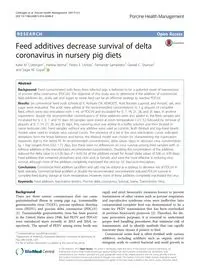
2017 Feed additives decrease survival of delta coronavirus in nursery pig diets PDF
Preview 2017 Feed additives decrease survival of delta coronavirus in nursery pig diets
RESEARCH Open Access Feed additives decrease survival of delta coronavirus in nursery pig diets Katie M. Cottingim1, Harsha Verma2, Pedro E. Urriola1, Fernando Sampedro2, Gerald C. Shurson1 and Sagar M. Goyal2* Abstract Background: Feed contaminated with feces from infected pigs is believed to be a potential route of transmission of porcine delta coronavirus (PDCoV). The objective of this study was to determine if the addition of commercial feed additives (e.i., acids, salt and sugar) to swine feed can be an effective strategy to inactive PDCoV. Results: Six commercial feed acids (UltraAcid P, Activate DA, KEMGEST, Acid Booster, Luprosil, and Amasil), salt, and sugar were evaluated. The acids were added at the recommended concentrations to 5 g aliquots of complete feed, which were also inoculated with 1 mL of PDCoV and incubated for 0, 7, 14, 21, 28, and 35 days. In another experiment, double the recommended concentrations of these additives were also added to the feed samples and incubated for 0, 1, 3, 7, and 10 days. All samples were stored at room temperature (~25 °C) followed by removal of aliquots at 0, 7, 14, 21, 28, and 35 days. Any surviving virus was eluted in a buffer solution and then titrated in swine testicular cells. Feed samples without any additive were used as controls. Both Weibull and log-linear kinetic models were used to analyze virus survival curves. The presence of a tail in the virus inactivation curves indicated deviations from the linear behavior and hence, the Weibull model was chosen for characterizing the inactivation responses due to the better fit. At recommended concentrations, delta values (days to decrease virus concentration by 1 log) ranged from 0.62–1.72 days, but there were no differences on virus survival among feed samples with or without additives at the manufacturers recommended concentrations. Doubling the concentration of the additives reduced the delta value to ≤ 0.28 days (P < 0.05) for all the additives except for Amasil (delta values of 0.86 vs. 4.95 days). Feed additives that contained phosphoric acid, citric acid, or fumaric acid were the most effective in reducing virus survival, although none of the additives completely inactivated the virus by 10- days post-inoculation. Conclusions: Commercial feed additives (acidifiers and salt) may be utilized as a strategy to decrease risk of PDCoV in feed, specially, commercial feed acidifiers at double the recommended concentrations reduced PDCoV survival in complete feed during storage at room temperature. However, none of these additives completely inactivated the virus. Keywords: Feed additives, Inactivation kinetics, Porcine delta coronavirus, Survival, Swine, Transmission, Virus Background There are three enteric coronaviruses that can cause gastrointestinal illness in young pigs e.g., transmissible gastroenteritis virus (TGEV), porcine epidemic diarrhea virus (PEDV), and porcine delta coronavirus (PDCoV) [1]. Transmissible gastroenteritis virus has been present in the United States since 1946, but PEDV and PDCoV were introduced more recently in 2013 and 2014, re- spectively. The spread of PEDV among swine herds was rapid; and strict biosecurity measures known to prevent transmission of other viruses such as porcine respiratory and reproductive syndrome virus were ineffective; later contaminated complete feed was demonstrated to be a route for PEDV transmission that has been overlooked in previous biosecurity protocols [2]. Therefore, for dis- ease prevention purposes, it is essential to understand proper feed handling procedures that minimize risk of transmission, and to identify methods that can rapidly inactivate these viruses if present in feed. Commercial swine feed is often fortified with various additives, including acidifiers such as organic and/or inorganic acids to control bacterial and mold growth in * Correspondence:
